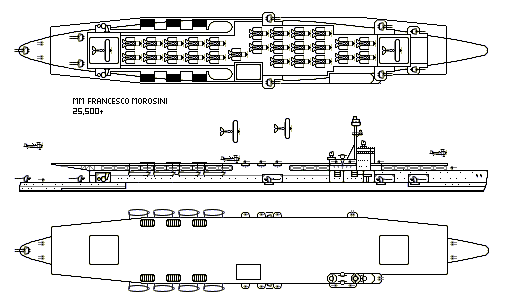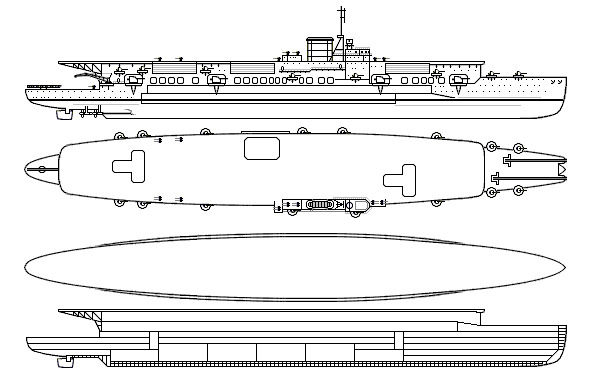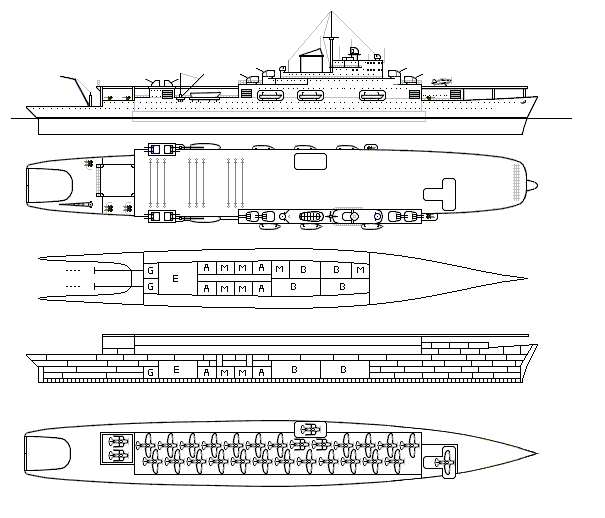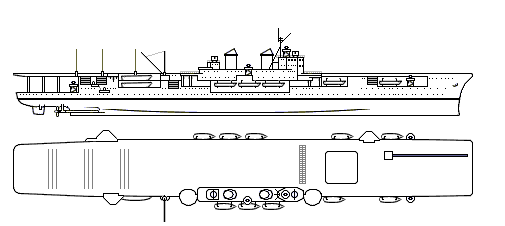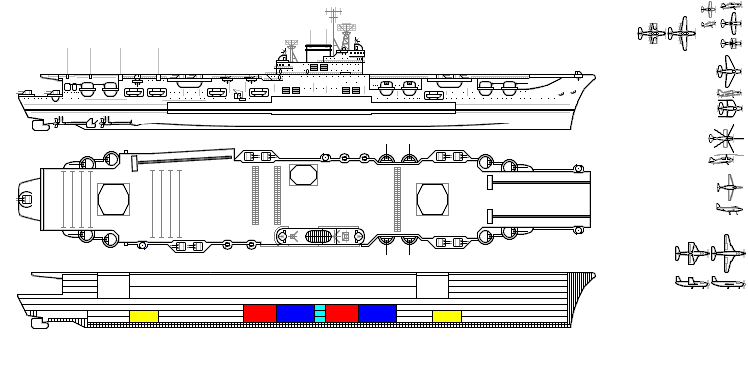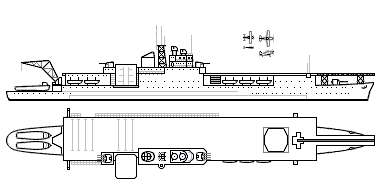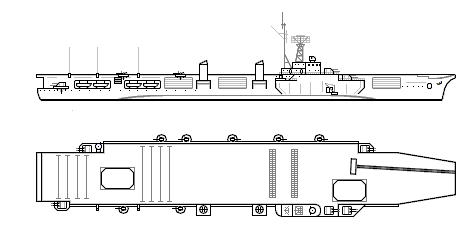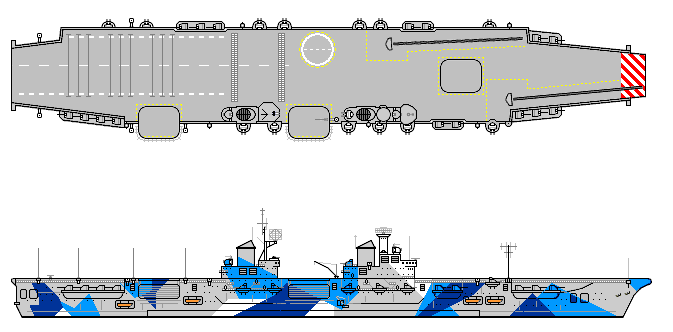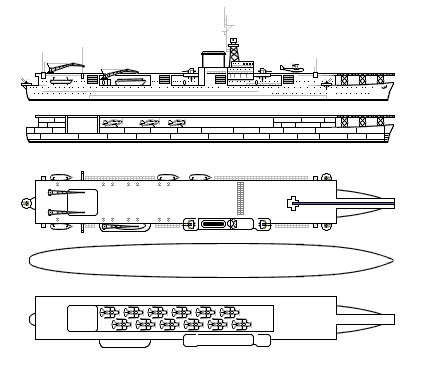
RN
Alberico da Barbiano ex-cruiser, refitted 1935, Sold to Siam 1940
RN
Bartolomeo Colloeoni ex-cruiser. refitted 1935, Sold to Siam 1940
Condottieri I, Italian Light Cruiser laid down 1925 (Engine 1930)
Displacement:
5,935 t light; 6,101 t standard; 6,664 t normal; 7,115 t full load
Dimensions: Length overall / water x beam x draught
539.12 ft / 524.93 ft x 52.49 ft x 19.69 ft (normal load)
164.32 m / 160.00 m x 16.00 m x 6.00 m
Armament:
4 - 3.94" / 100 mm guns (2x2 guns), 33.07lbs / 15.00kg shells, 1925 Model
Anti-aircraft guns in deck mounts
on side, all amidships, all raised mounts - superfiring
12 - 0.98" / 25.0 mm guns (3x4 guns), 0.52lbs / 0.24kg shells, 1925 Model
Anti-aircraft guns in deck mounts
on side, evenly spread, all raised mounts
Weight of broadside 139 lbs / 63 kg
Shells per gun, main battery: 400
Armour:
- Belts: Width (max) Length (avg) Height (avg)
Main: 2.76" / 70 mm 449.48 ft / 137.00 m 8.69 ft / 2.65 m
Ends: Unarmoured
Main Belt covers 132 % of normal length
- Gun armour: Face (max) Other gunhouse (avg) Barbette/hoist (max)
Main: 0.79" / 20 mm 0.39" / 10 mm -
2nd: 0.39" / 10 mm - -
- Armour deck: 1.38" / 35 mm, Conning tower: 0.79" / 20 mm
Machinery:
Oil fired boilers, steam turbines,
Geared drive, 2 shafts, 72,600 shp / 54,159 Kw = 33.96 kts
Range 3,000nm at 20.00 kts
Bunker at max displacement = 1,014 tons
Complement:
368 - 479
Cost:
£1.732 million / $6.927 million
Distribution of weights at normal displacement:
Armament: 16 tons, 0.2 %
Armour: 898 tons, 13.5 %
- Belts: 428 tons, 6.4 %
- Torpedo bulkhead: 0 tons, 0.0 %
- Armament: 6 tons, 0.1 %
- Armour Deck: 458 tons, 6.9 %
- Conning Tower: 6 tons, 0.1 %
Machinery: 2,200 tons, 33.0 %
Hull, fittings & equipment: 2,323 tons, 34.9 %
Fuel, ammunition & stores: 729 tons, 10.9 %
Miscellaneous weights: 498 tons, 7.5 %
Overall survivability and seakeeping ability:
Survivability (Non-critical penetrating hits needed to sink ship):
5,836 lbs / 2,647 Kg = 191.3 x 3.9 " / 100 mm shells or 1.0 torpedoes
Stability (Unstable if below 1.00): 1.11
Metacentric height 2.3 ft / 0.7 m
Roll period: 14.5 seconds
Steadiness - As gun platform (Average = 50 %): 70 %
- Recoil effect (Restricted arc if above 1.00): 0.04
Seaboat quality (Average = 1.00): 1.03
Hull form characteristics:
Hull has rise forward of midbreak
and transom stern
Block coefficient: 0.430
Length to Beam Ratio: 10.00 : 1
'Natural speed' for length: 26.38 kts
Power going to wave formation at top speed: 60 %
Trim (Max stability = 0, Max steadiness = 100): 68
Bow angle (Positive = bow angles forward): 10.00 degrees
Stern overhang: 9.84 ft / 3.00 m
Freeboard (% = measuring location as a percentage of overall length):
- Stem: 24.61 ft / 7.50 m
- Forecastle (20 %): 22.97 ft / 7.00 m
- Mid (38 %): 22.97 ft / 7.00 m (14.76 ft / 4.50 m aft of break)
- Quarterdeck (15 %): 14.76 ft / 4.50 m
- Stern: 14.76 ft / 4.50 m
- Average freeboard: 18.01 ft / 5.49 m
Ship tends to be wet forward
Ship space, strength and comments:
Space - Hull below water (magazines/engines, low = better): 117.6 %
- Above water (accommodation/working, high = better): 158.4 %
Waterplane Area: 17,967 Square feet or 1,669 Square metres
Displacement factor (Displacement / loading): 113 %
Structure weight / hull surface area: 78 lbs/sq ft or 380 Kg/sq metre
Hull strength (Relative):
- Cross-sectional: 0.95
- Longitudinal: 1.57
- Overall: 1.00
Hull space for machinery, storage, compartmentation is cramped
Room for accommodation and workspaces is excellent
Ship has slow, easy roll, a good, steady gun platform
Barbettes = 98tons
400tons = 12 fighters
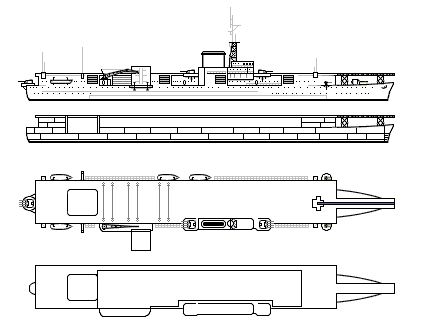 As refitted 1935
As refitted 1935
Condottieri I, Italian Light Cruiser laid down 1925 (Engine 1934)
Displacement:
5,602 t light; 5,781 t standard; 6,664 t normal; 7,371 t full load
Dimensions: Length overall / water x beam x draught
539.12 ft / 524.93 ft x 52.49 ft x 19.69 ft (normal load)
164.32 m / 160.00 m x 16.00 m x 6.00 m
Armament:
1 - 5.98" / 152 mm guns in single mounts, 110.23lbs / 50.00kg shells, 1925 Model
Breech loading gun in deck mount
on centreline forward
12 - 1.85" / 47.0 mm guns (3x4 guns), 3.86lbs / 1.75kg shells, 1925 Model
Anti-aircraft guns in deck mounts
on side, evenly spread
4 - 1.85" / 47.0 mm guns (2x2 guns), 3.86lbs / 1.75kg shells, 1925 Model
Anti-aircraft guns in deck mounts
on side, all forward
Weight of broadside 172 lbs / 78 kg
Shells per gun, main battery: 400
Armour:
- Belts: Width (max) Length (avg) Height (avg)
Main: 2.76" / 70 mm 449.48 ft / 137.00 m 8.69 ft / 2.65 m
Ends: Unarmoured
Main Belt covers 132 % of normal length
- Gun armour: Face (max) Other gunhouse (avg) Barbette/hoist (max)
Main: 0.79" / 20 mm 0.39" / 10 mm -
2nd: 0.39" / 10 mm 0.39" / 10 mm -
3rd: 0.39" / 10 mm - -
- Armour deck: 1.38" / 35 mm, Conning tower: 1.42" / 36 mm
Machinery:
Oil fired boilers, steam turbines plus diesel motors,
Geared drive, 2 shafts, 62,000 shp / 46,252 Kw = 32.63 kts
Range 5,000nm at 20.00 kts
Bunker at max displacement = 1,589 tons
Complement:
368 - 479
Cost:
£1.513 million / $6.053 million
Distribution of weights at normal displacement:
Armament: 20 tons, 0.3 %
Armour: 903 tons, 13.6 %
- Belts: 428 tons, 6.4 %
- Torpedo bulkhead: 0 tons, 0.0 %
- Armament: 6 tons, 0.1 %
- Armour Deck: 458 tons, 6.9 %
- Conning Tower: 11 tons, 0.2 %
Machinery: 1,784 tons, 26.8 %
Hull, fittings & equipment: 2,096 tons, 31.4 %
Fuel, ammunition & stores: 1,062 tons, 15.9 %
Miscellaneous weights: 800 tons, 12.0 %
Overall survivability and seakeeping ability:
Survivability (Non-critical penetrating hits needed to sink ship):
6,924 lbs / 3,141 Kg = 64.6 x 6.0 " / 152 mm shells or 1.2 torpedoes
Stability (Unstable if below 1.00): 1.10
Metacentric height 2.3 ft / 0.7 m
Roll period: 14.6 seconds
Steadiness - As gun platform (Average = 50 %): 71 %
- Recoil effect (Restricted arc if above 1.00): 0.04
Seaboat quality (Average = 1.00): 1.14
Hull form characteristics:
Hull has rise forward of midbreak
and transom stern
Block coefficient: 0.430
Length to Beam Ratio: 10.00 : 1
'Natural speed' for length: 26.38 kts
Power going to wave formation at top speed: 58 %
Trim (Max stability = 0, Max steadiness = 100): 62
Bow angle (Positive = bow angles forward): 10.00 degrees
Stern overhang: 9.84 ft / 3.00 m
Freeboard (% = measuring location as a percentage of overall length):
- Stem: 24.61 ft / 7.50 m
- Forecastle (20 %): 22.97 ft / 7.00 m
- Mid (38 %): 22.97 ft / 7.00 m (14.76 ft / 4.50 m aft of break)
- Quarterdeck (15 %): 14.76 ft / 4.50 m
- Stern: 14.76 ft / 4.50 m
- Average freeboard: 18.01 ft / 5.49 m
Ship tends to be wet forward
Ship space, strength and comments:
Space - Hull below water (magazines/engines, low = better): 103.1 %
- Above water (accommodation/working, high = better): 158.4 %
Waterplane Area: 17,967 Square feet or 1,669 Square metres
Displacement factor (Displacement / loading): 123 %
Structure weight / hull surface area: 70 lbs/sq ft or 343 Kg/sq metre
Hull strength (Relative):
- Cross-sectional: 0.87
- Longitudinal: 1.41
- Overall: 0.91
Caution: Hull subject to strain in open-sea
Hull space for machinery, storage, compartmentation is adequate
Room for accommodation and workspaces is excellent
Ship has slow, easy roll, a good, steady gun platform
Barbettes = 98tons
700tons = aircraft and vehicles

